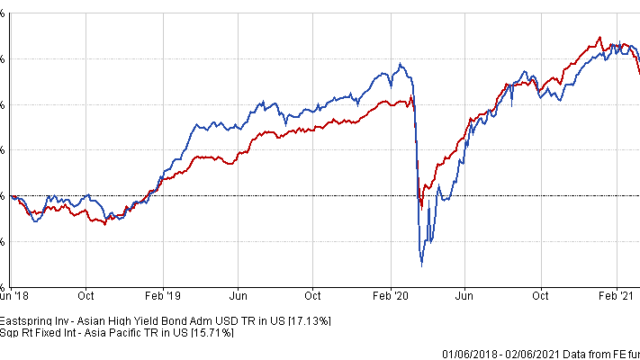Wai Mei Leong, Eastspring Investments
The sector boasts attractive yields, manageable defaults and shorter duration than credit in other regions, and Asian high yield bonds can benefit from Asia’s economic recovery.
“It should be one of the first stops for yield seeking investors,” said Wai Mei Leong, a fixed income portfolio manager at Singapore-based Eastspring Investments.
The average yield of Asia high yield bonds is 7.6%, with a duration of 2.5 years and credit quality of B+, according Eastspring research. Comparable characteristics for US high yield are 4.3%, 4.1 years and B+, and for European high yield are 2.6%, 3.5 years and BB-.
Leong acknowledges that there is likely to be an uptick in onshore bond defaults in China given the government’s commitment to reforms and desire to reduce net leverage in the system. Several high-profile defaults last year and the China Huarong Asset Management debacle have demonstrated that the central government will no longer give blanket guarantees even to state-controlled entities.
However, “amid the noise, it is important to remember that the Chinese property sector dominates the Asia high yield bond market and is a key driver of returns,” said Leong.
The sub-sector’s interconnectedness with China’s GDP means that the government tries to make the appreciation in property prices relatively stable, while the transparency in Chinese property companies is high, with sales and pre-sales numbers reported on a monthly basis.
“Investors may also fail to appreciate that the Chinese property market is probably one of the most regulated in the world following the government’s move in 2020 to introduce caps for debt-to-cash, debt-to-assets and debt-to-equity ratios – dubbed the ‘three red lines’,” said Leong.
Leong manages the $455m Luxembourg-domiciled Eastspring Investments Asian High Yield Bond Fund.
The fund has generated a 17.13% three-year cumulative return, outperforming its sector average of 15.71%, according to FE Fundinfo. However, the fund is more volatile than its peers, due its high yield allocations, with annualised volatility of 9.95% compared with 5.35% during the same period.
Portfolio tilt
About half the portfolio is invested in Mainland China bonds, and property developers make up 37% of the fund, the fact sheet shows. Top individual holdings include Scenery Journey, East Tactic, Theta Capital, Renew Power Synthetic and Kaisa Group.
“Default rates across Asia in general are likely to rise as governments pare back their stimulus measures, but defaults should still be manageable,” said Leong.
From another perspective, a widening of spreads due to any unfounded fears over potential defaults offer opportunities for experienced investors to add alpha, she added, although she is cautious about Southeast Asian banks because non-performing loans are expected to rise.
Overall, however, given attractive valuations, higher yields and shorter duration, she believes the sector is poised to benefit from the region’s eventual economic rebound.
“Investors may want to ride out the near-term volatility,” she said.
Eastspring Asian High Yield Bond Fund vs sector average


















